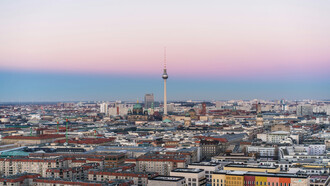While studying in Pécs, I was constantly drawn to the city's remarkable architectural diversity. Located in southern Hungary, Pécs is a city where history, modernity, and experimental design intersect unexpectedly. While many visitors admire its Roman ruins, Ottoman mosques, and Baroque palaces, I was drawn to the modernist and postmodern structures that add a unique layer to the city's built environment. From Bauhaus-inspired minimalist buildings to bold, theatrical postmodern experiments, Pécs offers an intriguing architectural journey that reflects the changing artistic and ideological movements of the 20th century.
Bauhaus influence and modernist architecture
Walking through the city, it's easy to see the impact of Bauhaus modernism, a movement that shaped much of Hungary's 20th-century architecture. In the 1920s, many students from Pécs traveled to Germany's Bauhaus school, where they embraced a functional, minimalist approach to design. Among these students were Fred Forbát and Farkas Molnár, two architects who later played a crucial role in bringing modernist principles to Hungary.
One of the most striking examples of this influence is the apartment building at 9-11 József Utca, designed by Fred Forbát. Its clean lines, geometric simplicity, and functionalist layout embody the Bauhaus ideal that architecture should be both aesthetically pleasing and practical. Forbát, who worked closely with Walter Gropius, helped introduce these principles to Hungary, mainly in Pécs.
Another key site is Bálványosi Villa (17 Kaposvári út), often referred to as "Pécs' Tugendhat Villa" due to its resemblance to the famous modernist landmark in Brno. Designed by Forbát, this villa showcases open spaces, natural light, and a seamless blend of functionality and elegance— perfectly representing Bauhaus philosophy.
A short walk away, Kallivoda Villa (18 Surányi Miklós út), designed by Farkas Molnár, stands as another testament to Bauhaus-inspired design in Pécs. Molnár, who later became one of Hungary's most influential modernist architects, created a structure that merges regional architectural traditions with modernist ideals, proving that Bauhaus was not just about universal design but also about adapting to local contexts.
While these buildings are some of the most visible examples, the influence of Bauhaus extends beyond Pécs, reaching Budapest, Szeged, and even international projects. Molnár worked on buildings in Germany and Austria, while Forbát later moved to Sweden, where he continued his modernist work. These architects were instrumental in expanding modernism beyond Hungary, showing how Bauhaus's ideas became a global phenomenon.
Pécs: the center of postmodern architecture in Hungary
Beyond its modernist legacy, Pécs is also Hungary's postmodern playground. While Bauhaus emphasized simplicity and functionality, postmodern architects sought to reinvent the past through playful exaggeration, bold colors, and eclectic forms.
One of the key figures in this movement was Sándor Dévényi, a Pécs-based architect who rejected modernism's minimalist ideals in favor of historical references, decorative flourishes, and whimsical designs. Dévényi's works are easily recognizable for their unexpected shapes, theatrical facades, and a sense of humor that challenges traditional architectural norms. Two of his most famous postmodern works in Pécs are Római Udvar and Munkácsy Udvar.
Római Udvar (13 Jókai Utca) is a curved, arch-filled masterpiece that combines historical and contemporary elements. The building's ornamental details, layered facades, and unique structural playfulness make it one of Pécs' most eye-catching postmodern designs. It resembles a blend. of ancient Roman influences with Art Nouveau elegance and contemporary boldness.
Nearby, Munkácsy Udvar (9 Munkácsy Mihály Utca) is a colorful, dynamic expression of postmodern architecture. Its theatrical design, exaggerated forms, and vibrant colors create a sense of movement, making it almost impossible to walk past without looking closer.
Not everyone embraced the postmodern movement in Hungary, however. Many traditional architects and critics dismissed it as overly decorative and impractical, arguing that it lacked the discipline of earlier styles. Yet, for architects like Dévényi, postmodernism was a liberation from rigid rules, a chance to make architecture artistic, expressive, and fun.
Preservation and future of architectural heritage in Pécs
As I continued exploring Pécs, I realized how important it is to preserve these modernist and postmodern buildings. Some Bauhaus-inspired structures have undergone careful restoration, while others face the risk of neglect or alteration. Meanwhile, postmodern works, which are still relatively young, have yet to be fully recognized as architectural heritage despite their unique role in shaping the city's identity.
In recent years, preservation efforts have gained momentum, with initiatives to protect Hungary's modernist and postmodern landmarks. Pécs, with its blend of Bauhaus rationality and postmodern creativity, stands as a living museum of 20th-century architectural experimentation.
Conclusion: a city of architectural surprises
Studying in Pécs has given me a deep appreciation for its architectural diversity. From the geometric clarity of Bauhaus-inspired buildings to the playful exuberance of postmodern experiments, the city offers a unique blend of rationalism and creativity, simplicity and ornamentation.
For anyone interested in architectural history, urban design, or simply the evolution of artistic expression, Pécs is a fascinating case study. It captures the spirit of change, adaptation, and experimentation, making it one of Hungary's most architecturally intriguing cities. Whether you're drawn to the functionality of modernism or the bold creativity of postmodernism, Pécs invites you to see architecture not just as buildings but as a reflection of ideas, culture, and imagination.















